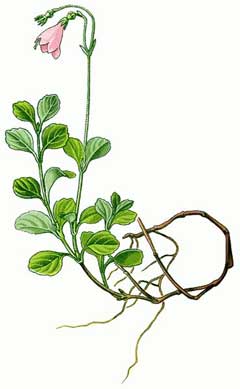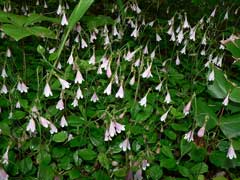 |
|
http://commons.wikimedia.org/wiki/File:Illustration_Linnaea_borealis0_fragment.jpg |
 |
| http://en.wikipedia.org/wiki/User_talk:Wsiegmund |
Translate this page:
Summary
Bloom Color: Pink. Main Bloom Time: Early summer, Late summer, Mid summer. Form: Prostrate, Spreading or horizontal.
Physical Characteristics

 Linnaea borealis is an evergreen Shrub growing to 0.2 m (0ft 8in) by 1 m (3ft 3in).
Linnaea borealis is an evergreen Shrub growing to 0.2 m (0ft 8in) by 1 m (3ft 3in).
See above for USDA hardiness. It is hardy to UK zone 2. It is in leaf all year, in flower from May to August. The species is hermaphrodite (has both male and female organs) and is pollinated by Insects.
Suitable for: light (sandy), medium (loamy) and heavy (clay) soils. Suitable pH: mildly acid soils and can grow in very acid soils.
It can grow in full shade (deep woodland) or semi-shade (light woodland). It prefers moist soil.
UK Hardiness Map
US Hardiness Map
Synonyms
Plant Habitats
Woodland Garden Dappled Shade; Shady Edge; not Deep Shade; Ground Cover;
Edible Uses
Edible Parts: Leaves
Edible Uses:
A food plant[177, 257]. No more details are given.
References More on Edible Uses
Medicinal Uses
Plants For A Future can not take any responsibility for any adverse effects from the use of plants. Always seek advice from a professional before using a plant medicinally.
Poultice Women's complaints
The plant has been used as a tonic in pregnancy and also in the treatment of painful or difficult menstruation[222]. The mashed plant is used as a poultice on inflamed limbs and is also applied to the head to ease the pain of headaches[257].
References More on Medicinal Uses
The Bookshop: Edible Plant Books
Our Latest books on Perennial Plants For Food Forests and Permaculture Gardens in paperback or digital formats.

Edible Tropical Plants
Food Forest Plants for Hotter Conditions: 250+ Plants For Tropical Food Forests & Permaculture Gardens.
More

Edible Temperate Plants
Plants for Your Food Forest: 500 Plants for Temperate Food Forests & Permaculture Gardens.
More

More Books
PFAF have eight books available in paperback and digital formats. Browse the shop for more information.
Shop Now
Other Uses
The plant forms an extensive twiggy mat and is useful as a ground cover on peat beds and in rock gardens[188]. Plants form a dense carpet when growing in god conditions, rooting as they spread, but otherwise the cover is sparse[208]. Plants should be spaced about 60cm apart each way[208].
Special Uses
Food Forest Ground cover Scented Plants
References More on Other Uses
Cultivation details
Landscape Uses:Ground cover, Rock garden, Woodland garden. Prefers a rather shaded position in a rock garden in a moist peaty soil[11, 200]. It grows well in pine woods[245]. Requires an acid soil[200]. Plants can be rather difficult to establish[200]. The sub-species L. borealis americana grows more freely than the European form. The plant is polymorphic[1]. The flowers have an evening fragrance like that of the honeysuckle[245]. Special Features:North American native, Fragrant flowers. The plant is heat tolerant in zones 9 through 6. (Plant Hardiness Zones show how well plants withstand cold winter temperatures.
Plant Heat Zones show when plants would start suffering from the heat.
The Plant Heat Zone map is based on the number of "heat days" experienced in a given area where the temperature climbs to over 86 degrees F (30°C).
At this temperature, many plants begin to suffer physiological damage. Heat Zones range from 1 (no heat days) to 12 (210 or more heat days).
For example Heat Zone. 11-1 indicates that the plant is heat tolerant in zones 11 through 1.) For polyculture design as well as the above-ground architecture (form - tree, shrub etc. and size shown above) information on the habit and root pattern is also useful and given here if available. An evergreen. A clumping mat former. Forming a dense prostrate carpet spreading indefinitely [1-2]. The root pattern is fibrous dividing into a large number of fine roots [1-2]. The root pattern is suckering with new plants from underground runners away from the plant [1-2].
References Carbon Farming Information and Carbon Sequestration Information
Temperature Converter
Type a value in the Celsius field to convert the value to Fahrenheit:
Fahrenheit:
The PFAF Bookshop
Plants For A Future have a number of books available in paperback and digital form. Book titles include Edible Plants, Edible Perennials, Edible Trees,Edible Shrubs, Woodland Gardening, and Temperate Food Forest Plants. Our new book is Food Forest Plants For Hotter Conditions (Tropical and Sub-Tropical).
Shop Now
Plant Propagation
Seed - best sown as soon as it is ripe in the autumn in a cold frame[188]. Sow stored seed as soon as possible, it is likely to require a period of cold stratification. When they are large enough to handle, prick the seedlings out into individual pots and grow them on in the greenhouse for their first winter. Plant them out into their permanent positions in late spring or early summer, after the last expected frosts. Division of rooted runners in the spring[188]. Layering. Cuttings of half-ripe wood in the summer[188]. They are rather slow to root[1].
Other Names
If available other names are mentioned here
Native Range
TEMPERATE ASIA: Georgia. NORTHERN AMERICA: Canada, Northwest Territories, Yukon, Québec, Nova Scotia, Ontario, Prince Edward Island, New Brunswick, Newfoundland and Labrador, Saskatchewan, Alberta, Manitoba, British Columbia, Nunavut, United States, Alaska, Connecticut, Indiana, Maine, Massachusetts, New Hampshire, New York, Rhode Island, West Virginia, Minnesota, North Dakota, South Dakota, Arkansas, New Mexico, Arizona, California, EUROPE: Denmark, Finland, United Kingdom (U.K.), Norway, Austria, Switzerland, Czech Republic, Germany, Netherlands, Poland, Latvia, Russian Federation, Karelia, Former Yugoslavia, Italy, Romania, France,
Weed Potential
Right plant wrong place. We are currently updating this section.
Please note that a plant may be invasive in one area but may not in your area so it's worth checking.
Conservation Status
IUCN Red List of Threatened Plants Status :

Growth: S = slow M = medium F = fast. Soil: L = light (sandy) M = medium H = heavy (clay). pH: A = acid N = neutral B = basic (alkaline). Shade: F = full shade S = semi-shade N = no shade. Moisture: D = dry M = Moist We = wet Wa = water.
Now available:
Food Forest Plants for Mediterranean Conditions
350+ Perennial Plants For Mediterranean and Drier Food Forests and Permaculture Gardens.
[Paperback and eBook]
This is the third in Plants For A Future's series of plant guides for food forests tailored to
specific climate zones. Following volumes on temperate and tropical ecosystems, this book focuses
on species suited to Mediterranean conditions—regions with hot, dry summers and cool, wet winters,
often facing the added challenge of climate change.
Read More
Expert comment
Author
L.
Botanical References
1117200
Links / References
For a list of references used on this page please go here
Readers comment
| Add a comment |
|
If you have important information about this plant that may help other users please add a comment or link below. Only comments or links that are felt to be directly relevant to a plant will be included. If you think a comment/link or information contained on this page is inaccurate or misleading we would welcome your feedback at [email protected]. If you have questions about a plant please use the Forum on this website as we do not have the resources to answer questions ourselves.
* Please note: the comments by website users are not necessarily those held by PFAF and may give misleading or inaccurate information.
To leave a comment please Register or login here All comments need to be approved so will not appear immediately.
|
Subject : Linnaea borealis
|
|
|
|